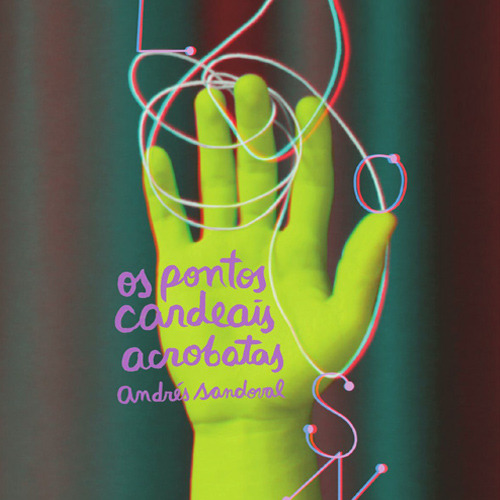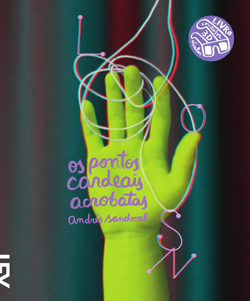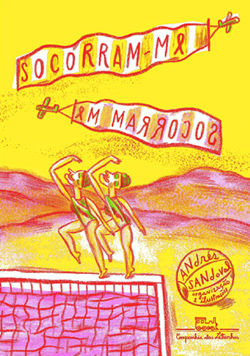< Back to posts
Andrés Sandoval
Brazil

Andrés Sandoval is a graphic artist who studied Architecture at São Paulo University. Since graduating, he's created books with publishers such as Companhia das Letras, Cosac Naify and Planeta Tangerina. He's also produced artwork for numerous companies and brands including Coca-Cola, L’Occitane and The New Yorker.
In this post, Andrés presents two unique books which have very different visual languages, but are linked by symmetries. ‘Os Pontos Cardeais Acrobatas’ (The Acrobatic Cardinal Points) is published by Cosac Naify, and ‘Socorram-me em Marrocos’ (Help me in Morocco) is published by Companhia das Letras.
Andrés: The first of the two books I will talk about in this post is called ‘Os Pontos Cardeais Acrobatas’ (The Acrobatic Cardinal Points).
This project began on a trip to Japan in 2008 when I found a magazine that came with a cutout 3D pinhole – one of those unbelievable Japanese objects. When I got back to Brazil I produced a series of publications made with this machine and also some 3D drawings. I often start with small fanzines and sketches that I can consult in order to design a book.
The challenge was to use 3D language as a poetic device and not just a magical effect. It was also essential to consider the book as an object, with simple things like sheets superimposed, bound and folded to one side, with the intention of being able to leaf through from one side to another – a device I am always returning to in my work.
Behind the cat's cradle game is my admiration for creating drawings with the hands in which the vertices are our own fingers. There is a delicateness in keeping the game going, without competition, where the goal is only to create figures. The players can afford to risk, at any moment, seeing their figures dismantled or becoming a knot. In this book, each hand is located on one page. By leafing through the pages, the hands touch each other like in the real game, and the lines fly over the book. That was the image which I pursued and wanted to see in print.
With the help of a photographer friend and assistant designer, we carried out around five photo sessions in a studio to get the texture, the light and the size of the images. We also captured the texture and the colour of the curtain and the lines, as well as the gesture of the hands (curiously this led us into unnatural positions at the time of shooting). In my childhood, the cat's cradle had never been my speciality, so it was necessary to study the game – learning from specialised books to get a sequence of steps to be shown throughout the book.
On the photographed lines I decided on a graphic intervention. Perhaps by virtue of my motivation as an illustrator, I created characters balancing on the tightrope. It reminded me of a play that takes place on the moon by Vicente Huidobro (a Chilean poet who inhabits my depths), where four trained cardinal points are presented.
After personally seeing Calder's circus in MoMA's collection, as well as the books of Sol LeWitt, it became easier to realise these single characters. While hands play to make stars with the string, the cardinal points dance with each other and become a rainbow, a compass rose, a tower, and various other things.
Onto the next book, ‘Socorram-me em Marrocos’ (Help me in Morocco).
Like the cat's cradle, this project also uses symmetries. While in ‘The Acrobatic Cardinal Points’ there is an almost hypnotic devotion to the mirrored image, this book had the challenge of undoing these figures.
The proposal for this project was to illustrate palindromes (noting that palindromes are those small sentences that can be read backwards). When I approached the subject, I realised that I was surrounded by geometries, pure forms and folds, and there was also an idea that perhaps the best book would be made only with letters.

After drawing a lot and even abandoning the project, I got back into it with a strong decision of leaving aside those mirrored images and typographical studies to make room for more open and humorous interpretations. The project turned into a dare – an effort to assert the illustrations.

I worked with a simpler and more familiar language to reflect my point of view about the sentences. The only mirror was the relation between text and image: one says one thing, the other one answers, and vice versa – and thereby finding the best angle to observe these small crystals.

Gradually, I discovered figures such as synchronised swimming, Alice's mirror, Medusa, and stalactites. I became increasingly seduced by the natural eccentricity of palindromes. There is a certain ‘mystery of discovery’ in them; once the words come together, nobody wants to tear them apart. It is nice to see them together.

Here are some palindromes with their translations: ‘Ser cor e ser ocres / Being colour and being ochre’, ‘Lá vou eu em meu eu oval / There I go, in my oval I’, ‘Rir, o breve verbo rir / To laugh, the short verb to laugh’, ‘Ele parece tecer a pele / He seems to weave the skin’, and ‘Socorram-me em Marrocos / Help me in Morocco‘, which became the title of the book, and is an excerpt from one of the most famous palindromes in Brazilian Portuguese.
Illustrations and photographs © Andrés Sandoval. Post translated by Gengo and edited by dPICTUS.
Os Pontos Cardeais Acrobatas /
The Acrobatic Cardinal Points
Andrés Sandoval
Cosac Naify, Brazil, 2013
The four cardinal points present their acrobatics on the tightrope...
This 3D book from Andrés Sandoval explains how to play the famous ‘cat's cradle’ game while the cardinal points dance over the strings, trying to form the compass rose.
Made with twenty-three anaglyphs. 3D glasses included.
Socorram-me em Marrocos /
Help me in Morocco
Andrés Sandoval
Companhia das Letras, Brazil, 2014
A selection of twelve Brazilian Portuguese palindromes, selected and illustrated by Andrés Sandoval.
‘Palindrome’ in Greek means ‘to run back’, and it's exactly this that defines them... All of these lines can be read either from left to right or from right to left – as if the words were running back to say exactly the same thing, but in the opposite direction.
At the end of the book, Andrés talks about this ‘phenomenon’ of our language.












